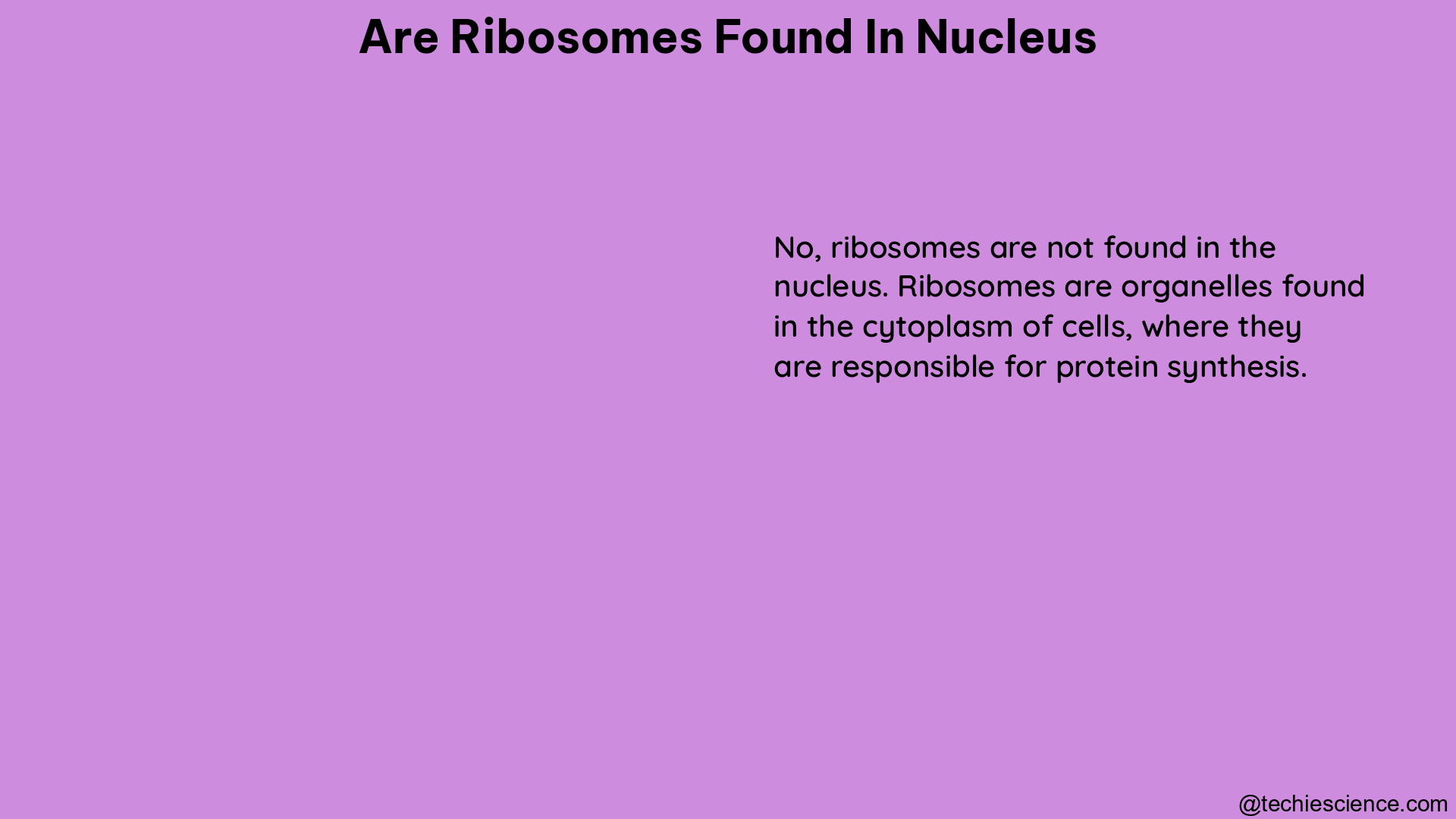Ribosomes, the cellular organelles responsible for protein synthesis, are not found within the nucleus of eukaryotic cells. Instead, they reside in the cytoplasm and on the rough endoplasmic reticulum (RER). However, the process of ribosome synthesis, including the production of ribosomal RNA (rRNA) and the assembly of ribosomal subunits, does occur within the nucleus.
The Nucleus and Ribosome Synthesis
The nucleus is the control center of the eukaryotic cell, housing the genetic material (DNA) and serving as the site for various essential cellular processes, including the synthesis of ribosomes. The process of ribosome synthesis, also known as ribosome biogenesis, takes place in a specialized region within the nucleus called the nucleolus.
The Nucleolus and Ribosome Synthesis
The nucleolus is a distinct, darkly staining region within the nucleus where the synthesis of ribosomal components occurs. This process involves the following steps:
-
Transcription of rRNA Genes: The DNA sequences encoding for the different types of ribosomal RNA (28S, 5.8S, 5S, and 18S rRNA) are transcribed by RNA polymerase I and III within the nucleolus.
-
Processing of rRNA: The newly synthesized rRNA transcripts undergo a series of processing steps, including cleavage, modification, and folding, to produce the mature rRNA molecules.
-
Ribosomal Protein Assembly: Ribosomal proteins, which are synthesized in the cytoplasm, are transported into the nucleus and assemble with the processed rRNA to form the small (40S) and large (60S) ribosomal subunits.
-
Ribosomal Subunit Export: The completed ribosomal subunits are then exported from the nucleus through the nuclear pores and transported to the cytoplasm, where they can participate in protein synthesis.
Regulation of Ribosome Synthesis
The synthesis of ribosomes is a highly regulated process, as it is essential for the cell’s growth and proliferation. The rate of ribosome synthesis is influenced by various factors, including:
-
Nutrient Availability: Nutrient stress, such as a lack of amino acids or glucose, can lead to a decrease in ribosome synthesis and a reduction in the overall ribosome inventory within the cell.
-
Cell Cycle: The rate of ribosome synthesis is closely linked to the cell cycle, with increased ribosome production during periods of active cell growth and division.
-
Signaling Pathways: Cellular signaling pathways, such as the mTOR (mammalian target of rapamycin) pathway, can regulate the transcription of rRNA genes and the assembly of ribosomal subunits.
-
Transcription Factors: Specific transcription factors, such as c-Myc and p53, can influence the expression of genes involved in ribosome synthesis.
Ribosomes in the Cytoplasm and on the RER

While the synthesis of ribosomes occurs in the nucleus, the ribosomes themselves are not found within the nuclear compartment. Instead, they are located in the cytoplasm and on the rough endoplasmic reticulum (RER).
Cytoplasmic Ribosomes
Cytoplasmic ribosomes are free-floating in the cytoplasm and are responsible for the synthesis of proteins that are not destined for secretion or integration into cellular membranes. These ribosomes can move freely throughout the cytoplasm, allowing them to translate mRNA transcripts and produce a diverse range of proteins.
Ribosomes on the RER
A significant portion of ribosomes are found associated with the rough endoplasmic reticulum (RER), a network of interconnected membrane-bound structures within the cytoplasm. Ribosomes bound to the RER are responsible for the synthesis of proteins that are destined for secretion, incorporation into cellular membranes, or transport to other organelles.
The RER provides a specialized environment for the co-translational folding and modification of these proteins, ensuring their proper structure and function.
Quantitative Analysis of Ribosome Inventory under Nutrient Stress
In a recent study published in the journal Cell Reports, researchers at Harvard Medical School conducted a systematic quantitative analysis of ribosome inventory in response to nutrient stress. The study revealed the following insights:
-
Ribosomal Protein Abundance: The researchers measured the abundance of ribosomal proteins (r-proteins) in various cell lines, including 293T cells, ATG7 −/−, RB1CC1 −/−, 293 cells, ATG5 −/−, and HCT116 cells, ATG5 −/− or RB1CC1 −/−.
-
Nutrient Stress and Autophagy: The study found that ribosomal proteins were affected by nutrient stress and active autophagy, a cellular process that recycles damaged or unnecessary components.
-
Quantitative Measurements: The researchers used normalized total cell extracts processed for 8 11-plex TMT-MS 3 experiments to quantify the abundance of r-proteins.
-
Reduction in Ribosomes: The results showed that the mean ratio value measured for 70 or more r-proteins was comparable to the reduction in ribosomes measured by total proteome analysis, indicating a reduction of ribosomes from approximately 5-8% under nutrient stress conditions.
This study highlights the importance of understanding the regulation of ribosome synthesis and inventory in response to various cellular stresses, as it has implications for cellular homeostasis, growth, and disease processes.
Conclusion
In summary, while the process of ribosome synthesis occurs within the nucleus, the ribosomes themselves are not found in the nucleus. Instead, they are located in the cytoplasm and on the rough endoplasmic reticulum, where they perform their essential function of protein synthesis. The regulation of ribosome synthesis is a complex and tightly controlled process that is influenced by various factors, including nutrient availability, cell cycle, and signaling pathways.
References:
– Quizlet – Biology 1 Midterm Flash Cards
– NCBI – Systematic Quantitative Analysis of Ribosome Inventory upon Nutrient Stress
– Khan Academy – Nucleus and Ribosomes

Hello, I am Sugaprabha Prasath, a Postgraduate in the field of Microbiology. I am an active member of the Indian association of applied microbiology (IAAM). I have research experience in preclinical (Zebrafish), bacterial enzymology, and nanotechnology. I have published 2 research articles in an International journal and a few more are yet to be published, 2 sequences were submitted to NCBI-GENBANK. I am good at clearly explaining the concepts in biology at both basic and advanced levels. My area of specialization is biotechnology, microbiology, enzymology, molecular biology, and pharmacovigilance. Apart from academics, I love gardening and being with plants and animals.
My LinkedIn profile-